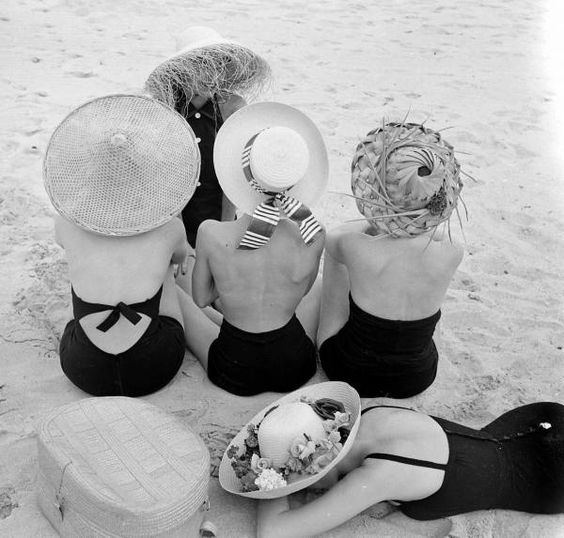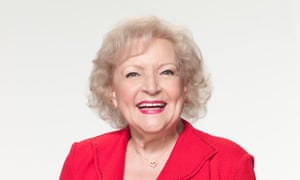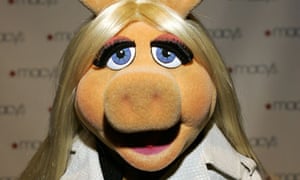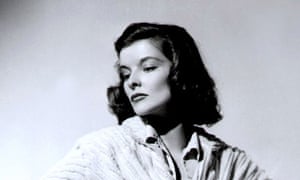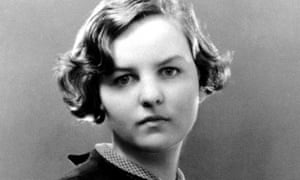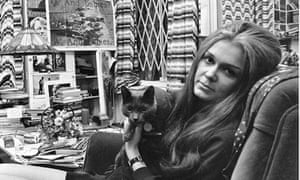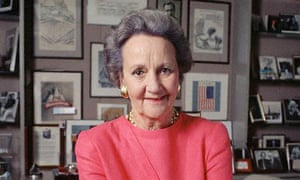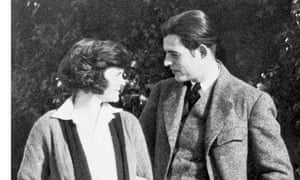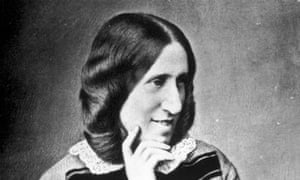Katharine Hepburn, the actress whose independent
life and strong-willed movie characters made her a role model for
generations of women and a beloved heroine to filmgoers for more than 60
years, died yesterday at her home in the Fenwick section of Old
Saybrook, Conn. She was 96 and also had a home in Manhattan.
Her physical presence was distinctive, her
often-imitated voice filled with the vowels of a well-bred New
Englander, and her sharp-planed face defined by remarkably high
cheekbones. In her youth she did not have classical leading-lady looks,
but a handsome beauty. In old age she was a familiar figure with her
hair, gradually changing from auburn to gray, always in a topknot and
her boyish figure always in the trousers that she helped to make
fashionable.
She played sharp-witted, sophisticated women with an
ease that suggested that there was a thin line between the movie role
and the off-screen personality. The romantic comedy "The Philadelphia
Story" and the screwball classic "Bringing Up Baby" were among her best,
most typical roles. But through 43 films and dozens of stage and
television appearances, she played comic and dramatic parts as varied as
Jo in "Little Women," the reborn spinster Rosie in "The African Queen"
and Eleanor of Aquitaine in "The Lion in Winter."
Her life and career were dominated by her love
affair with Spencer Tracy, which created one of the great romantic
legends and brilliant movie pairings of their day. Tracy was unhappily
married and the father of two when they met, and he remained married
until the end of his life. He and Miss Hepburn lived together for 27
years, until his death in 1967, and made nine films together.
"Woman of the Year," "Adam's Rib" and "Pat and Mike"
are typically bright and biting Tracy-Hepburn collaborations. She is
wickedly smart, slightly aloof and emotionally vulnerable. He is
commonsensical, down-to-earth and deeply decent. He manages to bring her
down a peg; she never minds.
Hepburn and Tracy, Vincent Canby wrote in The New
York Times , "so beautifully complemented each other" that their
relationship "never seemed to be a matter of capitulation." Rather, he
added, it was "a matter of understanding and acknowledging each other's
boundaries."
The frisson of their off-screen romance, always
hinted at but never acknowledged during his lifetime, followed them on
screen and became especially poignant when they played a married couple
in their last movie together, "Guess Who's Coming to Dinner." Tracy died
just 17 days after they had finished filming it.
Through most of her career, Miss Hepburn had a
reputation for being private and elusive with the press. In fact, she
frequently granted interviews, although she was reticent about her
personal life. But after the death of Tracy's wife, Louise, in 1983,
Miss Hepburn felt free to discuss the love affair.
In later years she spoke openly about her life and
career, especially in her 1991 autobiography, "Me: Stories of My Life"
(Alfred A. Knopf). Although admittedly sketchy rather than a
comprehensive memoir, the book captured the qualities that endeared Miss
Hepburn to audiences: a conversational tone, a no-nonsense attitude and
disarming candor. The autobiography became a best seller, a tribute to
her enduring appeal across generational lines.
In 1993 she appeared in an autobiographical
television documentary, "Katharine Hepburn: All About Me," made for the
TNT cable network. She began: "So this is about Katharine Hepburn,
public, private. Can you tell which is which?" She added, laughing,
"Sometimes I wonder myself."
Longing to Be a Boy
Katharine Houghton Hepburn was born into a close
family whose comfortable social status and unconventional opinions
fostered self-confidence and independence. Her father, Dr. Thomas Norval
Hepburn, was a Hartford surgeon and a pioneer in fighting venereal
disease. Her mother, Katharine Houghton, was a suffragist and a strong
advocate of birth control.
In "Me," Miss Hepburn finally revealed her age. "I
was born May 12, 1907," she wrote, "despite everything I may have said
to the contrary." For years she had said she was two years younger and
had given her birthday as Nov. 8. That was the birthday of her older
brother, Tom, who died at 16. Miss Hepburn, then 14, found his body
hanging from the rafters of a house the family was visiting in New York
City. The Hepburns said they never knew whether he had committed suicide
and left open the possibility that he had been practicing a magic
trick.
Although the family always called her Kathy or Kath,
one summer Miss Hepburn so hated being a little girl that she cut her
hair and called herself Jimmy. "I thought being a girl was really the
bunk," she said in an interview. "But there's no bunk about Jimmy."
After graduating from Bryn Mawr College in 1928, she
had small parts in stock theater companies. She was dismissed from more
than one play when she was starting out, but she retained supreme
self-confidence. Late in life, she laughingly said of her younger self,
"I am terribly afraid I just assumed I'd be famous."
She was first noticed professionally in her role as
Antiope in the play "The Warrior's Husband," a Greek fable in which she
entered by descending a narrow staircase, carrying a stag over her
shoulder.
That role led to a Hollywood screen test and her
first film role, as John Barrymore's daughter in "A Bill of Divorcement"
(1932). It was directed by George Cukor, who become one of her dearest
friends (she and Tracy lived for years in the guest house on Cukor's
Hollywood estate) and the director of many of her films, including
"Little Women." He once recalled of her screen test: "She was unlike
anybody I'd ever seen or heard. I was rather moved by the test, although
the performance wasn't that good. But I thought, `That girl is rather
interesting.' "
Fast Rise to Stardom
Miss Hepburn became a movie star quickly. She won an
Academy Award for her role as Eva Lovelace, the naïve aspiring actress
who learns a tough lesson about survival, in the 1933 film "Morning
Glory," only her third movie. Over the years she was nominated for a
dozen Oscars, more than any other actress, a record unbeaten until Meryl
Streep received her 13th this year. Miss Hepburn won three more, for
"Guess Who's Coming to Dinner," "The Lion in Winter" and "On Golden
Pond," but never showed up to collect any of them.
When she was 84, she looked back at those early days
and, with her trademark tough-mindedness, said: "In the beginning I had
money; I wasn't a poor little thing. I don't know what I would have
done if I'd had to come to New York and get a job as a waiter or
something like that. I think I'm a success, but I had every advantage; I
should have been."
She also credited her husband with helping her get
started in her career. For most of her life, the public thought she had
never married. In fact, in 1928 she married Ludlow Ogden Smith, a member
of a wealthy Pennsylvania family. She immediately made him change his
name to S. Ogden Ludlow, partly because she didn't want to be known as
Kate Smith.
They led separate lives long before their divorce in
1934, but they remained friendly. The town house they bought together
in the Turtle Bay section of Manhattan was Miss Hepburn's home until the
end of her life (along with the family home on the Connecticut River,
to which she returned often).
In later years she expressed regret at the way she
had treated her husband. In an interview that echoed what she wrote in
"Me," she assumed a self-chastising, no-nonsense tone and said she had
been "an absolute pig with Luddy, absolute pig." She continued: "He was
an angel. I thought of myself first, and that's a pig, isn't it?"
"I would have been terrified alone in New York
City," she said. "We bought this house in '31, and then the minute I won
the Academy Award, I got rid of Luddy." Many years later, not long
before he died, "I tried to make up to him for the horror I had caused
him," she added. "He was so generous-spirited that I don't think he
considered it horror. He just considered it a kid who was wildly
ambitious or something."
Miss Hepburn is survived by a brother, Dr. Robert H.
Hepburn, and a sister, Margaret H. Perry, both of Canton, Conn.; four
nieces; and nine nephews.
Trousers as a Trademark
Despite her early success, reviewers in those days
sometimes found her strident and mannered. In 1933 she returned to
Broadway in a spectacular failure, "The Lake," which inspired Dorothy
Parker to write her famous aphorism, "She ran the gamut of emotion from A
to B."
Of those early years, she said: "I strike people as
peculiar in some way, although I don't quite understand why. Of course, I
have an angular face, an angular body and, I suppose, an angular
personality, which jabs into people."
Over time her screen presence softened and became
more likable; meanwhile, society was catching up to her willful,
independent style. She had been wearing pants, then considered quite
unladylike, since the 1930's.
In her 1993 television autobiography, she recalled:
"I realized long ago that skirts are hopeless. Anytime I hear a man say
he prefers a woman in a skirt, I say: `Try one. Try a skirt.' " Although
her choice was based on comfort, her trademark trousered look became so
influential that the Council of Fashion Designers of America gave her a
lifetime achievement award in 1986.
Many of her early films are now regarded as
classics. Playing a tough, determined actress in "Stage Door" (1937),
she read a line from a play — "The calla lilies are in bloom again" —
that became the all-time favorite of Hepburn impersonators. Life
magazine said that "Stage Door" proved that she was "potentially, the
screen's greatest actress."
She played a free-spirited heiress in "Bringing Up
Baby" (1938), opposite Cary Grant and a leopard. But the film, now
treasured, was a box-office flop, and by then her career was in decline.
In 1938 she appeared on a list of actors labeled "box-office poison" in
a poll of movie exhibitors.
Rather than appear in a film called "Mother Carey's
Chickens," she bought out her contract with R.K.O. She made "Holiday,"
another classic romantic comedy with Grant, in which she was another
high-spirited socialite.
Then Miss Hepburn took charge of her career in a way
few women dared in those days of the studio system. Philip Barry wrote
the play "The Philadelphia Story" for her, modeling his heroine, Tracy
Lord, on Miss Hepburn. Tracy Lord is a beautiful, high-spirited rich
woman, about to marry her second husband, when her first husband and a
reporter who is covering the wedding arrive to create an unexpected
romantic tangle.
The play was a hit, and Miss Hepburn owned the
rights to it because Howard Hughes, a sometime beau, had bought them for
her. She went to Louis B. Mayer, the head of the Metro-Goldwyn-Mayer
studio, and sold him the property on the condition that she play the
lead. She chose her friend George Cukor to direct. And she asked for
Spencer Tracy and Clark Gable as her co-stars. She got Cary Grant as her
former husband, James Stewart as the reporter, and a hit movie. She
never lost control of her career again.
Soon she went back to Mayer with another script,
"Woman of the Year," the story of the unlikely romance between a hotshot
political columnist and a sportswriter. She asked for Tracy, whom she
had never met, to play the sportswriter. This time she got him.
A Loving Partnership
The success of "Woman of the Year" (1942) and the
stars' off-screen relationship led to other Tracy and Hepburn films that
followed a similar pattern. In "Adam's Rib" (1949), they are married,
opposing lawyers, both nicknamed Pinky. In "Pat and Mike" (1952), she is
a champion athlete, and he is her rough-hewn manager, with whom she
falls in love.
The film was devised to show off Miss Hepburn's
well-cultivated athletic ability. Almost to the end of her life she
played tennis and swam, and in earlier years she golfed.
It was in "Pat and Mike" that Tracy spoke the
often-quoted line about Miss Hepburn's figure, "Not much meat on her,
but what's there is `cherce.' "
Miss Hepburn often said Tracy was the best actor she
had ever known and compared him in complimentary terms to a baked
potato: solid, substantial stuff. "He's meat and potatoes, meat and
potatoes," she would say. "I'm more like a fancy French dessert, I'm a
little bit fancy, aren't I? But I wish I were meat and potatoes." Her
other films with Tracy included the political dramas "Keeper of the
Flame" (1942) and "State of the Union" (1948).
One of her most enduring films without Tracy was
"The African Queen" (1952), in which she played the straitlaced Rosie
opposite Humphrey Bogart for the director John Huston.
She wrote about it in her first book, published in
1987, whose title captures the direct, colloquial style of her writing:
"The Making of the African Queen: Or, How I Went to Africa With Bogart,
Bacall and Huston and Almost Lost My Mind" (Knopf).
Later she achieved one of her great artistic
triumphs in an unlikely role, as the 12th-century Eleanor of Aquitaine
in "The Lion in Winter" (1968). There was still something of the typical
Hepburn persona in the steely manipulation and breaking heart of the
aging, dismissed queen, but none of the actress's contemporary
mannerisms.
Her versatility lasted well into her career. She
played the distraught, drug-addicted Mary Tyrone in the 1962 film of
Eugene O'Neill's "Long Day's Journey Into Night." She was a fair match
in toughness for John Wayne in the western "Rooster Cogburn" (1975). And
in "On Golden Pond" (1981) she starred opposite Henry Fonda as a feisty
older woman coping with her husband's failing memory and insisting that
they should go on and live life to the fullest. In that role, the
on-screen and off-screen Hepburn seemed to meld as easily as they had in
her youth.
Her final screen appearance, in 1994, was a minor
but tremendously emotional role in "Love Affair." Playing Warren
Beatty's wise old aunt, she gave advice to the woman he loved, played by
Annette Bening. Miss Hepburn's age gave the role the trappings of a
farewell to movies, but if she moved more slowly than before, in
demeanor she was as game and modern as she had ever been, even venturing
an unprintable line about ducks.
Throughout her career, she returned to the stage
periodically. She appeared in "The Millionairess," by George Bernard
Shaw, on Broadway in 1952. In the late 1950's she also appeared in
several Shakespeare plays in Stratford, Conn.
And in 1969, when she was 62, she made her singing
debut on Broadway in the Alan Jay Lerner musical "Coco," based on the
life of the fashion designer Coco Chanel. She also appeared on Broadway
in 1976 in "A Matter of Gravity," by Enid Bagnold, and in 1981 in "The
West Side Waltz," by Ernest Thompson, who had written "On Golden Pond."
Her performances in all three of these plays were
received with dazzling praise; the works themselves were treated more
harshly. Walter Kerr of The New York Times wrote about her performance
in "The West Side Waltz" in terms that reflected the general critical
opinion: "One mysterious thing she has learned to do is breathe
unchallengeable life into lifeless lines."
A Beloved Aunt on TV
In the 1970's she acted in television movies,
including the Edwardian romantic drama "Love Among the Ruins" (1975),
with Laurence Olivier, and "The Corn Is Green" (1979), both directed by
Cukor. And in later years she kept busy with minor television movies.
She played a fictional version of the typically
feisty Kate Hepburn character in "Mrs. Delafield Wants to Marry" (1986),
"Laura Lansing Slept Here" (1988) and "The Man Upstairs" (1992).
In 1994 she appeared in a few scenes in the
television movie "One Christmas," as yet another wise old aunt. Her
tailor-made Hepburn lines included these: "I've always lived my life
exactly as I wanted. I wouldn't change a single thing. No regrets."
As she aged, she had some physical problems from
which she recovered well. She had hip-replacement surgery and operations
on both her shoulders, but she remained spry. Although her head shook
visibly in television interviews from the 1980's on, she vehemently
denied the rumor that she had Parkinson's disease, saying she had
inherited her shaking head from her grandfather Hepburn.
Her most striking television appearance was not in a
dramatic role, but in a 1986 tribute to Spencer Tracy. Speaking openly
about their relationship at last, she read a letter she had written to
him, which she later included in her autobiography. She recalled their
last years together, when he was ill and had trouble sleeping, and she
would sit on the floor by his side and talk. She wondered why he drank.
"What was it, Spense?" she asked. It was an eloquent
and sentimental performance that distilled the way her public and
private lives blended.
At the conclusion of "All About Me," her own
television biography, she said: "In some ways I've lived my life as a
man, made my own decisions. I've been as terrified as the next person,
but you've got to keep a-going; you've got to dream." In typical
Katharine Hepburn style, she faced the camera and, at the age of 85,
tacitly acknowledged how close she had to be to the end.
"I have no fear of death," she said. "Must be
wonderful, like a long sleep. But let's face it: it's how you live that
really counts."
